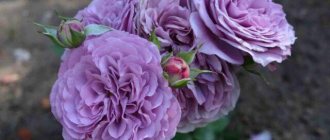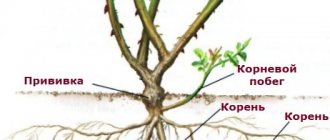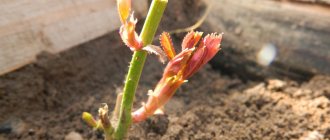Diseases, pests and ways to combat them
Roses may be susceptible to the following diseases:
- Gray rot. It affects buds with pedicels, which are covered with a white coating. Roses with light flowers are most often affected by this. A gliocladin tablet placed under the plant in May and August will cope with this.
- Infectious burn. Overtakes the plant after removing the cover. A bright red ring appears on the shoots, turning black. Over time it dies off. The diseased shoot is cut off to the healthy part and treated with the drug “RanNet”.
Aphids, scale insects, caterpillars, May beetles, and pennies can harm the bush. They are eliminated using manual sampling.
Rose lovers will appreciate this variety. If you provide it with proper care, you can count on prolific flowering.
White climbing roses in landscape design
When decorating landscape design, white climbing roses are used to decorate arches, gazebos, recreation areas, or planted next to the wall of a building. Some varieties wrap around supports in quite interesting ways. Quite often, white roses are used as ground cover plants, as a result of which you can get a snow-white carpet of roses on your site.
Rose blossom
The White Meidiland rose is a repeat-blooming variety. The flowering process occurs from spring until autumn in two distinct waves. Abundant flowering occurs in the first wave; leaves are practically invisible. During the second wave, long shoots (1.1 m) appear, which subsequently droop due to the weight of the blooming flowers.
Re-blooming is ensured by summer pruning. It is necessary to get rid of faded flowers. This stimulates growth and the appearance of more buds.
Important! After flowering in the fall, overgrown rose bushes should be trimmed and branches infected with fungi should be removed. This will help rejuvenate the plant, prevent the development of diseases, and improve its decorative appearance.
Why it doesn’t bloom and what to do
The ground cover rose Blank Meyandecor may not bloom due to improper care, poor planting location, unsuitable climate, or infection with fungal diseases. You can solve the problem by transplanting the plant to another place, properly pruning it and treating it with antifungal agents.
Advantages of the rose "Nadya Meyandekor"
Undoubtedly, the rose “Nadya Meyandekor” deserves to live in the garden, since it meets all the expectations of rose growers. It tolerates recurrent spring frosts, summer heat and autumn cold well. Its dense bush is resistant to infectious diseases of roses and damage by pests. Winters well in the climatic conditions of the middle zone, although this rose is classified in zone 6.
For a ground cover rose with a prostrate bush height of about half a meter, an adult plant “Nadya Meyandekor” has rather large, densely double flowers (9-10 cm in diameter). At the ends of the stems and on the growing side branches of its drooping long (80-100 cm) shoots, 3-5 oval buds are formed simultaneously. As a result, each shoot is constantly covered with new buds and flowers at different stages of dissolution.
The buds open slowly and the blooming flowers are very beautifully shaped. Charming flowers that remain decorative for a long time look great against the backdrop of numerous bright green leaves shining in the sun. Blooming early at the very beginning of summer, the spreading rose bush “Nadya Meyandekor” blooms continuously and profusely until the end of the garden season, until the onset of significant frost.
Rose Blanc Meyandecor or Maidiland
The variety was first bred in 1987 in France. Rose White Maidiland is a spreading bush with thick, stiff shoots of a light green hue. According to the description, the height of the plant can reach a maximum of 140 cm. The width varies between 120-215 cm.
Double rose flowers are white with a slightly pinkish edge. They gather in inflorescences of 5-10 pieces. Each flower has about 60-70 petals. The size of the flower is 7-9 cm. The aroma of the flower is weakly expressed.
Rose Blanc Meillandecor
Large glossy leaves of a typical shape have a dark green color. The stems are strewn with a large number of thorns. This rose bush is great for growing in a container or on the lawn. The plant can be used as a ground cover, decorating the garden. Its advantages include resistance to frost and rainy weather, long-term repeat flowering.
Important! The plant has good resistance to diseases such as powdery mildew and black spot
Rosa Blanc in landscape design
Description of white roses
The main meaning of these flowers has long been known: a symbol of innocence and purity. In the past, white roses were used to declare love or, conversely, to hint to a girl that she is not ready to get married. According to scientists, the appearance of white varieties of roses dates back to the times of Ancient Egypt and the Roman Empire, when these flowers began to be mentioned in records and used in the form of images.
White Rose
The flower belongs to the Rosehip genus. The size of the buds varies from small in bush species to large in single flowers. The shape can be spreading or narrow pyramidal. The height of the bush is on average from 25 cm to 60 cm, climbing roses can reach a length of 2-5.5 m. The peduncle can reach a length from 10 cm to 80 cm. The number of petals in a bud varies from 5 to 128. The aroma of the plant is also varied , like the varieties of white roses themselves. Here you can find a classic Damask aroma, fruity, citrus and spicy notes.
It is important to know! The description allows you to distinguish one type of flower from another. Knowing the varieties makes it possible to properly grow flowers and care for them during growth and after the end of the growing season.
Care instructions
The varieties described above are quite unpretentious in care. They are very weakly susceptible to disease, recover well from mechanical damage and do not need frequent watering.
Note! These plants take root in almost any soil, as long as it is not very acidic. For planting in the garden, a sunny, not too windy place at a distance of 2-3 meters from other plants is suitable, since these roses can fill someone else’s territory with their shoots
Therefore, periodically, usually in the spring, they should be pruned and thinned.
For planting in the garden, a sunny, not too windy place at a distance of 2-3 meters from other plants is suitable, since these roses are capable of filling someone else’s territory with their shoots. Therefore, periodically, usually in the spring, they should be pruned and thinned.
High frost resistance from -40 to -20°C allows these varieties to not need shelter for the winter.
Important! Standard roses must be covered for the winter. https://www.youtube.com/embed/hoRgN-AEIZg
Growing and caring for the Ohara White rose
Hybrid tea rose is grown in Colombia and Ecuador because the variety loves warm subtropical climates. The crop is endowed with high frost resistance, but does not tolerate rain and high air humidity, so growing it in the central and northern regions of Russia is not easy.
In cold regions, roses can be grown in greenhouses, creating an artificial favorable microclimate around it. It is important to provide the crop with bright lighting. In such conditions, the variety will bloom successfully and produce many elegant flowers from which you can create elegant bouquets.
If the nearest stores do not have seedlings of this variety, there is a chance to grow a rose from cuttings taken from a bouquet sold at a flower kiosk.
In a greenhouse, the variety needs no less care than in the open air. In spring, the plant is fed with nitrogen fertilizer, in summer - with mineral fertilizer. You can pour dry fertilizer directly under the bush.
It is recommended to ensure timely watering, avoiding drought around the ground; the plant should not be flooded either. It is advisable to add peat and humus from plants to the soil for planting roses.
Rose blossom
In order for a crop to bloom beautifully, you need to provide it with quality care. It must have an integrated approach.
Period of activity and rest
The culture is characterized by lush flowering, which begins in June and ends in October. Throughout the summer, buds form on the plants. According to gardeners' descriptions, the flowering resembles the Topala rose.
Care during and after flowering
In order for a culture to develop normally, it must be properly cared for. During the formation of buds, roses require potassium and phosphorus. To preserve the decorative appearance of the bushes, you need to immediately remove the faded buds.
What to do if it doesn't bloom
The lack of flowering may be due to the following factors:
- nutritional deficiencies;
- improper watering;
- thickening of plantings.
White Meidiland
White Meidiland, White Meilland (White Medyand)
Meilland France, 1987
Shrub
Description:
Can be cultivated as ground cover.
The flowers are white with a slightly pinkish edge of 60-70 petals, double, medium size, 6-9 cm, collected in inflorescences of 5-10 pieces. The leaves are large, dark green, shiny. The bush is spreading (width may exceed height). The shoots are thick, light green, hard, with numerous light thorns. Completely frost-resistant, profusely and long-flowering variety. The aroma is very weak or absent. An excellent plant for planting in lawns and containers.
Flower diameter, cm: 7-9
Bush dimensions (h*w, cm): 90-140*120-215
Resistance to fungal diseases: highly resistant
Flowering: re-blooming
Reviews from experienced rose growers:
Hardy, very beautiful white rose! (no pink around the edges was noticed - snow-white, without color changes), fluffy, neat, powerfully growing bush; The flowers have a very beautiful fluffy shape, they don’t show the middle, they last a very long time even in the hot sun! The foliage is dark, glossy - a wonderful background for them, always elegant and somehow cheerful! It so happened that 2 times, in August, it was still blooming, and in the spring, in a hurry, I had to replant it... it didn’t disappoint! and overwintered (at -20 only under the hill and a layer of grass) and will bloom for the second time (the flowers from the first flowering, quite presentable, were forcibly pruned so that the bush develops). According to the description, she is a shrub, I would argue... if she is a shrub, then it is not the classic low one, but closer to floribundas with slopes towards ground cover, because the bush is very compact, dense, fluffy, grows harmoniously in width and is all covered with flowers. Therefore, it is perfect for both the foreground and for a good dense border, if necessary. (Bandurina Yulia Valentinovna, Minsk)
I have had this rose for 4 years, it is winter-hardy, it has never been sick with anything, it blooms in two distinct waves, the first is the most abundant, the leaves are almost invisible. There are always buds and flowers between the waves. In the second half of summer, it shoots upward with long shoots, about 1.1 m, which gradually droop under the weight of the blooming flowers. The flower lasts a long time. Tolerates heat well. Grows in full sun. Height approximately 60cm, width 1.20. Self-cleaning, but sometimes the fading flowers turn brown around the edges, I don’t like it, so I tear it off. My rose has no scent at all. (Ulizko Irina Aleksandrovna, Volgograd)
This rose is a PERFECT WHITE GROUNDCOVER! Rose has a lot of advantages: quite large flowers, always absolutely white, they are not afraid of heat, as well as rain, they last a long time and bloom neatly. The foliage is simply a sight to behold: not small, very beautiful, glossy and not just dark green, but even with notes of “malachite” and the white flowers only emphasize it even more. Not a single diseased leaf was noticed during the season! Nothing but delight! (Loginova Nadezhda Nikolaevna, northern Moscow Region)
Wonderful rose!!! Favorite!!! It actually overwinters very well, does not get sick, and blooms in large clusters of up to 10 flowers, or even more. I admire the bloom of this rose!!!! (Oksana Dmitrievna, Kodyma, Odessa region)
Description of the White Ohara variety
The White Ohara variety has average resistance to diseases, does not tolerate high humidity, but tolerates frost well. The aroma of rose is very strong, pronounced, combining light astringency and cloying sweetness. The shrub is tall, semi-spreading, flowers are double.
| Color | White |
| Number of flowers per stem | 1 |
| Aroma | Very strong |
| Flower size | 10-14 cm |
| Average number of petals | 55 |
| Frost resistance | Frost-resistant, zone 6 |
| Bush height | 120-150 cm |
| Powdery mildew resistance | Average, gets sick in unfavorable years |
| Black spot resistance | Average, gets sick in unfavorable years |
| Rain resistance | Weak, flowers do not open when it rains |
| Flower | Terry |
| Bloom | Reblooming |
| Bush | Semi-spreading |
Plant care
Rose White Maidiland requires care, like all plants. Basic care rules include a number of procedures.
Trimming
It is recommended to prune the rose at the end of winter, when it has lost its foliage, before spring. For those living in a warm region, it is better to prune in January. All leaves and flowers must be cut off. This will ensure the plant rests before flowering. To do this, use sharp hand pruners or pruners with a sliding blade. Dull pruners will damage the stems and buds.
Important! Black and dark brown stems should also be pruned for further growth.
Top dressing
After planting in the first year, the plant is fed only in the fall with fertilizers containing phosphorus, calcium and potassium. In the second year it will be possible to do spring and summer feeding.
Treatment
In rainy summers, it is recommended to treat the plant with copper sulfate to prevent the appearance of a fungal disease.
Shelter for the winter
Cover the base of the bush with earth, put spruce needles, cover with sand and cover with spruce branches. Carefully remove the lashes from the supports and place them on the spruce branches. Also lay spruce branches on top and wrap everything with film.
Important! In spring, it is necessary to gradually get rid of the shelter, opening the branches slightly, and then freeing the entire plant
Growing a flower: how to plant in open ground
You can grow Maidiland by seeds or seedlings. Each method has its drawbacks.
Selecting a location
Planting is carried out in a well-lit area with partial shade appearing alternately. Constant exposure to the sun will negatively affect the flower. He will get sick or burn out.
It is better to plant the plant on the western or southeastern side. Slightly acidic or neutral, loamy soil with a good drainage system and aeration is especially suitable for planting. The most optimal time for planting is 2-3 weeks before the onset of stable frosts. You can also plant the plant after a period of thawing of the soil.
Selection of seedlings
The seedling must be healthy. It must be trimmed before planting. Strong seedlings usually have 5 buds left. Seedlings of medium strength can have 3 buds. In a weakened seedling, the shoots are shortened to almost their entire length. You only need to leave 3 mm at the base.
Damaged roots are removed before healthy tissue begins. Then the roots of the bush are cut to 20-25 cm and dipped into a solution of water and “Kornevin” for 11-12 hours. Then the roots are moistened with a mixture of clay and mullein in proportions 3x1.
Preparing the site
To prepare the landing site, you need to do the following:
- At the chosen location, dig a hole measuring 60x60, 70 cm deep. Place the top layer on the edge of the hole.
- Place a drainage layer made of small pebbles, broken bricks and crushed stone at the bottom of the pit.
- Place a 40 cm layer of the prepared mixture of soil and fertilizers on top of the drainage. Then sprinkle the hole with a fertile layer.
Important! Planting holes must be prepared 10-14 days before planting roses in them. During this time the earth will have time to settle
Otherwise, the rose will go deeper.
Boarding order
To plant a plant, you need to do this:
- Place the seedling in the hole. At the same time, carefully straighten the roots and position the plant so that the root collar is approximately 4 cm below the top layer of soil.
- Sprinkle the planting area with soil and press down.
- Water the bush well. Each bush requires 10 liters of water.
After 2-3 days, it is necessary to loosen the soil and hill up to a height of 10 cm. If the rose was able to take root, then after 10-15 days the first young shoots will appear. After they appear, the bush can be unplanted. The best time for this procedure is cloudy weather.
Principles of white rose agricultural technology
White chickens
In order for a flower to have a look that matches its varietal characteristics, it is worth following the rules of planting and caring for plants.
Landing
Agricultural technology for white roses begins with choosing suitable soil and planting bushes in the ground. You should choose an open place where the plant will have access to sunlight. In this case, the place should be well protected from winds.
Soil acidity should be no less than 5.5 and no more than 6.5 pH. Loamy soil is best. Experts advise enriching it with humus and adding sand or peat in small doses. If a decision is made to create a full-fledged rose garden with a variety of varieties, each square meter of root layer should be fertilized with manure in a volume of 19-20 kg.
Planting begins at the end of August. The earth should be heated 20 cm deep. The landing pit should have a depth of 65-70 cm.
Planting a rose
Care
When growing delicate varieties of roses, not only the correct form of planting is important, but also caring for the plants themselves.
Most often, rose bushes are planted in autumn. In this case, you should remember that the plants must be prepared for wintering. They need to be spudded and covered with a special cloth.
Nutrition is also an important component of plant care. In the first year of life of the bushes, it is not recommended to feed them. Further, experts advise annually pruning the bushes and feeding them. The first fertilizer consists of a mixture of manure (3 kg) and ammonium nitrate (20-30 g). The second time it is best to feed the plants at the moment when the shoots begin to grow. During this period, you should use the special drug Kemira Universal-2. In the first half of July, both organic and mineral fertilizers are introduced into the “diet” of flowers.
Important! After July 14-15, it is not recommended to apply nitrogen fertilizers.
The period of another feeding occurs at the end of August and beginning of September. During this period, fertilizers based on phosphorus and potassium are used. Typically, this type of feeding is done once every two years.
An important element of rose garden care is pruning the bushes. This procedure will improve the decorative qualities of flowers. Pruning is divided into spring, summer and autumn. Heavy pruning makes it possible to remove branches to a height of 3-4 buds, medium pruning: from 5 to 7 buds. In turn, light pruning of the plant preserves 8-15 buds from the level of the base of the stem. According to experts, after pruning, the next 2-3 buds begin to actively grow.
In spring, pruning of the bush is done immediately after the overwintered bush opens. The cut should be located at a height of 5 mm from the selected bud. After the unnecessary part of the bush branch is cut off, it is best to treat the cut with a 1% solution of copper sulfate or a 3% solution of Bordeaux mixture. This makes it possible to protect the plant from fungal infections.
Pruning done in summer is aimed at removing heads that have already faded. This allows the buds below to begin to develop more actively. Also, summer pruning can be aimed at forming a certain crown shape.
In autumn, pruning is necessary to remove leaves. It is produced in October. Shoots should be shortened by ½ of their length.
Note! One of the scourges of a rose garden can be wild growth. Its removal is carried out along with summer pruning of bushes.
Winter is an important period for keeping plants alive. To properly winter the bushes, they need to be prepared. Hilling should be carried out in September (height 20-30 cm). During dry weather, pruned plants should be treated against fungal and bacterial infections. Experts advise creating an air-dry type of plant shelter. It can be organized like a small hut.
The plant should be cleaned and opened when the soil warms up by 20 cm. It is during this period that the rose bush can develop independently.
Flower propagation
Blanc Meillandecor rose is propagated by cuttings, layering and dividing the bush. Such bushes are classified as self-rooted. If the above-ground part dies, new shoots form from the root collar.
Important! The most common method is propagation by green cuttings. Rooting cuttings can be done directly in the garden bed
Harvesting cuttings occurs at the beginning of lignification of shoots. In the case of roses, this also occurs at the beginning of flowering.
Cuttings are prepared from the middle part of semi-lignified shoots during the flowering period. You need to leave 3 buds. The length of the cutting should be more than 7-10 cm. To avoid unnecessary evaporation of moisture, the leaves are cut to 1/3 or 2/3 of their length. You need to completely get rid of the bottom sheet. In addition, a straight upper cut of the cutting is made 0.5-1 cm above the bud and a lower oblique cut under the bud. After this, the cuttings are planted.











